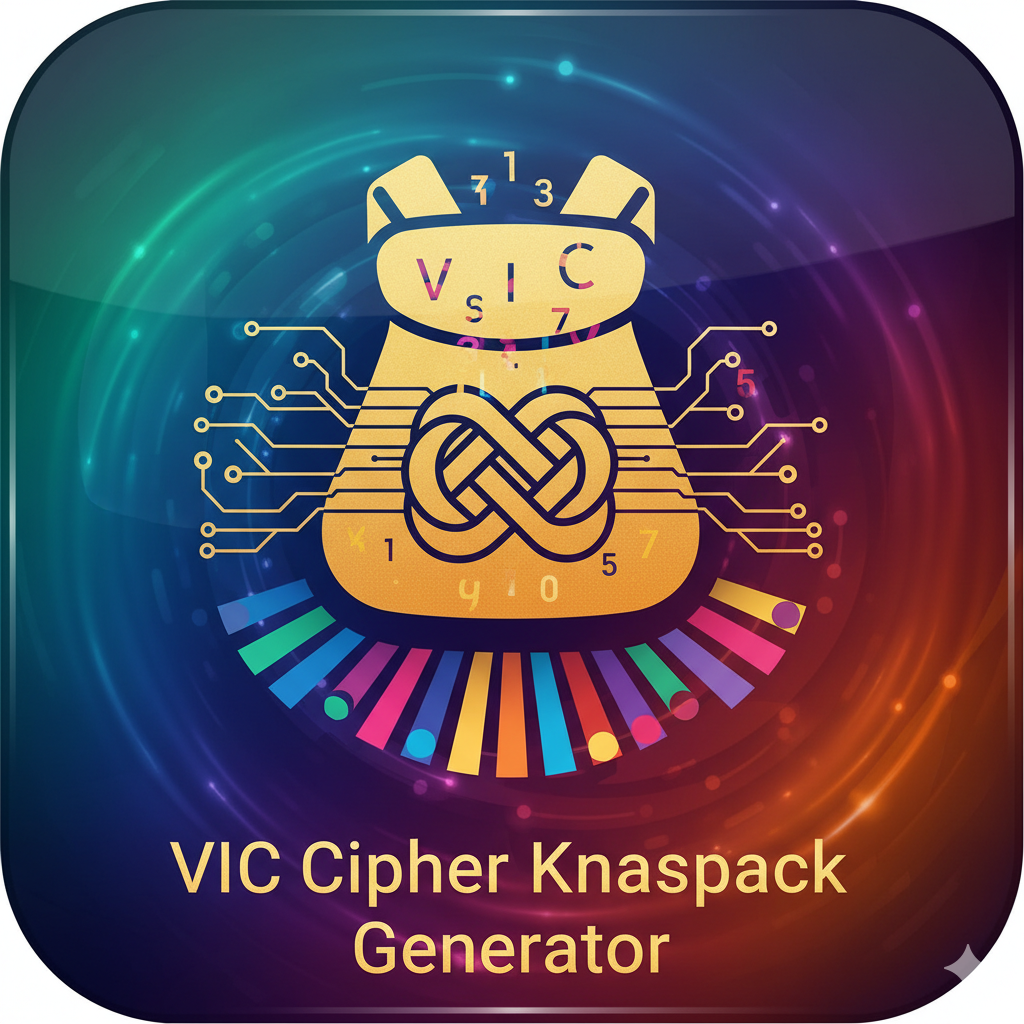VIC Knapsack Method
VIC Knapsack Method helps you prioritize tasks and projects. Optimize your workflow and make better decisions efficiently. Try it now!
The VIC Cipher Knapsack Tool 💼✨ is a full-featured interactive simulator for exploring and experimenting with the VIC Cipher — widely regarded as the most sophisticated manual encryption system ever deployed. Created by Soviet intelligence in the early 1950s, the VIC Cipher combined mathematical precision, psychological misdirection, and modular encoding steps to form a cipher so advanced it baffled Western cryptanalysts for years.
This tool focuses on the “Knapsack” (numbering) phase — the heart of the VIC Cipher — allowing users to generate, manipulate, and decode numerical key sequences, transpositions, and chain additions exactly as real spies once did. Perfect for students of cryptography, puzzle solvers, and intelligence historians, it’s the ultimate hands-on introduction to Cold War–era tradecraft.
⚙️ Key Features:
🔢 Knapsack Generator & Visualizer
Create or load a personalized VIC “Knapsack” — the numeric foundation of the cipher, built using pseudo-random chains and modulo operations.🧮 Automatic Chain Addition Simulation
Watch the chain addition process unfold step-by-step, generating long pseudo-random sequences from small key seeds — just as KGB agents did.🗝️ Customizable Key Inputs
Input key phrases, random seeds, or agent-specific numbers (like ID codes and dates) to replicate historical encryption workflows.📊 Digit Distribution Analyzer
View the numeric frequency, index shifts, and modular carryovers in real-time — ideal for understanding how the VIC achieved both randomness and reproducibility.🧩 Polybius Square Integration
After generating your knapsack, automatically populate the straddling checkerboard used in later cipher steps to encode plaintext into digits.🔍 Transposition Stage Emulator
Apply and visualize double transposition grids that use numbers from the knapsack to permute and reorder encoded messages.💻 Encode & Decode Modes
Switch between encryption and decryption, visualizing each stage of the VIC process — from knapsack generation to numeric transposition and reconstruction.🧠 Step-by-Step Learning Mode
See every mathematical transformation in sequence:Key phrase → Chain addition → Knapsack sequence
Checkerboard encoding → Double transposition
Final ciphertext assembly
🕰️ Historical Examples Included
Try reproducing real VIC Cipher setups, including the infamous Reino Häyhänen (Codename: “VICTOR”) cipher, used by Soviet spies in 1953 and decrypted only through human error, not cryptanalysis.💾 Save & Export Ciphers
Store your knapsack configurations and ciphertext results for further study or puzzle creation.
💡 How It Works (Simplified):
The VIC Cipher is not a single algorithm but a multi-step hybrid system combining arithmetic, substitution, and transposition.
Key Derivation (Knapsack Phase)
Start with personal key numbers (date, ID, or keyword).
Apply chain addition (each new digit is the sum of two previous digits mod 10).
Continue until a long pseudo-random string — the “knapsack” — is produced.
Checkerboard Encoding
Convert plaintext into numbers using a straddling checkerboard based on the key sequence.
Double Transposition
Reorder the digits twice using numeric sequences derived from the knapsack.
Final Ciphertext Output
The result is a highly diffuse, non-repetitive numeric ciphertext.
Unlike many manual ciphers, the VIC’s nonlinear arithmetic structure and multi-stage dependency make it resistant to frequency analysis and pattern detection — it’s effectively a “paper-based one-time pad.”
🧭 Historical Significance:
The VIC Cipher was famously used by Reino Häyhänen (Agent VICTOR), a Soviet spy in the United States, to communicate with Moscow during the Cold War. It was discovered by the FBI in 1957 after Häyhänen’s defection — and despite modern analysis, cryptologists recognized it as the most mathematically sophisticated hand cipher ever designed.
It integrated techniques decades ahead of its time:
Modular arithmetic
Chain addition (a primitive pseudo-random generator)
Fractionated substitution
Variable transposition grids
Steganographic decoy content
The VIC Cipher Knapsack Tool honors that legacy by making these mathematical principles visual, interactive, and educational.
🌍 Perfect For:
🧑🏫 Teachers & Students exploring Cold War-era cryptography or manual cipher design.
🕵️♂️ Cryptography Enthusiasts testing classical-to-modern hybrid encryption systems.
💻 Developers & Puzzle Designers building intelligence-themed games or simulations.
📜 Historians & Researchers studying spy tradecraft and cryptographic evolution.
🧩 Escape Room Creators who want authentic, multi-layer cipher puzzles.
🔍 Why It’s Valuable:
The VIC Cipher Knapsack Tool bridges mathematics, intelligence history, and encryption design in a way no other cipher tool does. It offers:
✅ A deep dive into manual encryption logic that still impresses modern analysts.
✅ Step-by-step transparency to understand the cipher’s arithmetic brilliance.
✅ Interactive simulations that demonstrate the evolution from hand ciphers to machine ciphers.
It’s both a cryptographic laboratory and a historical reenactment — letting you experience the analytical mindset of Cold War code makers and breakers.
✨ In Short:
The VIC Cipher Knapsack Tool 🧠💼🔢 revives the world’s most advanced hand cipher — blending Cold War history, mathematical logic, and interactive cryptography. It helps you understand how Soviet agents encrypted secrets long before digital computers, and how modular arithmetic could create near-unbreakable paper-based encryption.
Generate. Transpose. Decode.
With the VIC Cipher Knapsack Tool, you don’t just study cryptography — you live it. 🕵️♀️📜🔐






